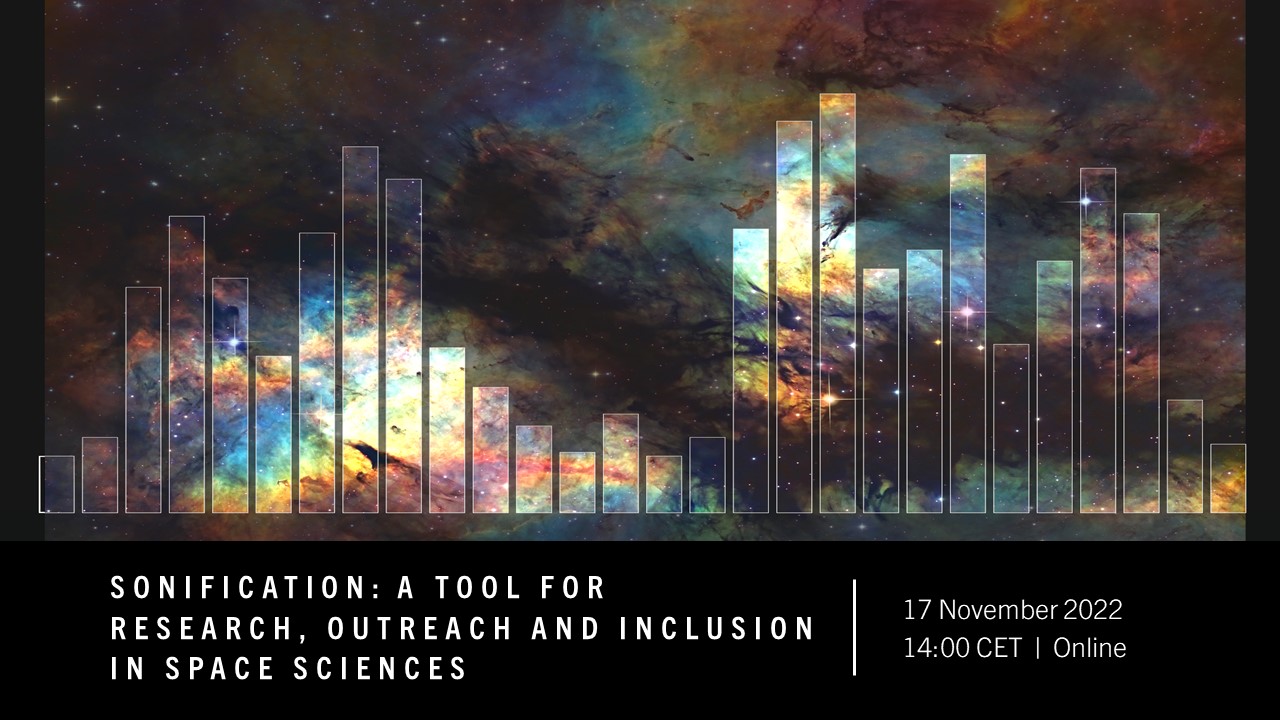Sonification: a tool for research, outreach and inclusion in space sciences
17 November 2022
Online
Background image credit: Butterfly nebula, Alan Pharm, Astrobin. Design: Veronika Bachleitner.
Background
UNOOSA is committed to advancing efforts towards an inclusive future for space sciences. The importance of science, technology and innovation will only grow in future. It is imperative to ensure that more people are empowered to access space sciences and contribute to international cooperation in the peaceful use and exploration of space.
For too long persons with disabilities have been excluded from full participation in space sciences. For persons who are blind and visually impaired (BVI), there are huge barriers to accessing the opportunities afforded by space science. One such barrier is the sector's reliance on data visualisation for research, outreach, and education. The power of spectacular images of space to inspire and spark curiosity is unquestionable, but by assuming that sight is the only way to explore space we exclude the BVI community, who have equal right to full participation in space sciences. In fact, astronomical data comes from multiple wavelengths that mostly cannot be seen by our eyes. By exploring different ways to interpret and communicate data we open doorways to new discoveries and a more inclusive future.
Sonification, in which non-verbal sound is used to interpret, analyse, and communicate data, is a powerful tool for equitable access to space sciences. However, there is much work still to be done. It is the responsibility of all of us, from UNOOSA to research institutions, to individuals, to encourage and advocate for tools like sonification, and commit to mainstreaming disability inclusion in our work. Only by working together can we build a truly diverse and inclusive space sector for the benefit of everyone.
Introduction
This online event aims to explore sonification as a tool that has the potential to contribute to scientific research, outreach and disability inclusion. This event comprises of two segments. Segment one showcases a diverse range of sonification projects in space sciences while segment two is an online panel discussion where we unpack the complexities surrounding the use of sonification in space sciences.
The panel discussion brings together professional astronomers and experts in sound perception, science communication and accessibility to discuss the current state of sonification in space science, challenges in implementation, recommendations on how to facilitate the advancement and adoption of sonification in space science research and outreach, and what to expect in the coming years.
Participants are encouraged to share their experiences and ask questions during the Q&A session. Ideas and information collected will inform an upcoming Space for Persons with Disabilities special report on sonification.
Objectives
- To raise awareness of the challenges facing persons with disabilities, in particular the BVI community, in space science research and outreach and the need for innovative solutions
- To explore the use of sonification as a tool to enhance the multi-sensory approach to scientific research and outreach, thereby advancing disability inclusion
- To identify key challenges that need to be addressed to realise the potential of sonification for disability inclusion in space science
- To collect ideas and information for a Space for Persons with Disabilities special report on sonification
- To contribute to the implementation of SDG 10: Reduced Inequalities
- To contribute to the implementation of the UN Disability Inclusion strategy
Programme
[Segment 1] Sonification projects in space sciences
Segment 1 is a compilation of short videos of sonification projects in space sciences. Each video introduces the purpose of the project and its sonification methodology, demonstrates sonified samples and provides information on resources.
The purpose of this segment is to showcase interesting sonification projects from around the world, raise awareness of how sonification can be applied to astronomy for outreach, research, and in particular, for inclusion of BVI persons. This is also an opportunity to foster international collaboration and exchange of ideas.
[Segment 2] Panel discussion
The purpose of the live panel discussion is to discuss the current state of sonification in astronomy, the challenges and the way forward, and to gather public feedback and suggestions on this topic. There will be a Q&A session following the panel discussion.
Participants are encouraged to view segment 1 before joining segment 2.
Date: Thursday, 17 November 2022
Time: 14:00 to 15:30 CET
Location: Online, on MS Teams
Speakers:
- Wanda Diaz-Merced, astronomer, European Gravitational Observatory, pioneer in sonification of astrophysical data
- Kimberly Arcand, visualization scientist and emerging technology lead for NASA's Chandra X-ray Observatory
- Scott Fleming, astronomer, Mikulski Archive for Space Telescopes, Space Telescope Science Institute
- Christopher Harrison, astrophysicist, Newcastle University, Audio Universe Director
- Alice Oates, PhD candidate, polar studies, University of Cambridge
The programme sheet and speakers' bios are available for download in accessible format. Click here to download.
Resources
Segment 1) Video showcasing sonification projects in space sciences is available on UNOOSA's YouTube channel via this link .
Segment 2) Video recording of the panel discussion is available via this link. The transcript is available here.
Subtitles are available in both videos.
Registration
Registration closed on Thursday, 17 November 2022, 12:00 CET.
Contact
For more information, please contact unoosa-events@un.org
